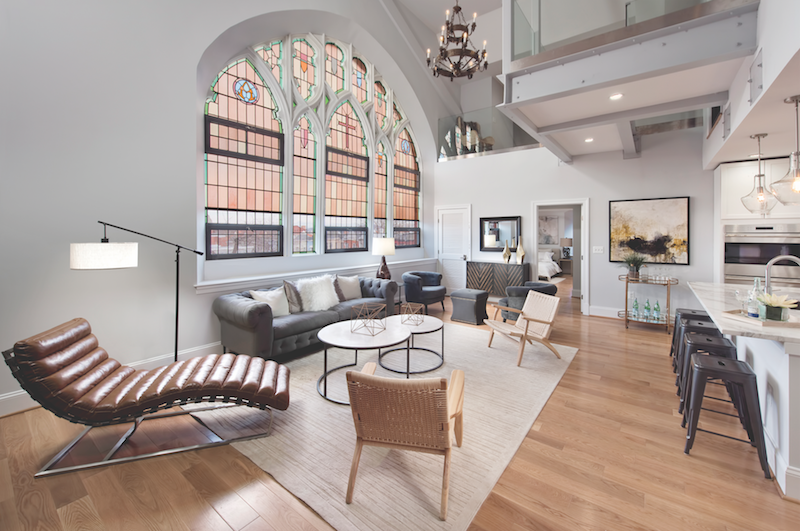One of the curious things about the Nation’s Capital is that, unlike many older U. S. cities, Washington, D. C., never had any industry to speak of—unless you count the manufacture of hot air as an industry. In the District of Columbia, you don’t see those wonderful 19th-century Italianate factories that dot the cityscapes of Boston, New York, Baltimore, Chicago—strong-boned, high-ceilinged brick edifices that convert into magnificent loft apartments, condominiums, and mixed-use centers.
What Washington does have aplenty is churches and other “religious locations” —by one count, 857, or one for every 758 residents. Until recently, the Way of the Cross Church, a Gothic Revival structure that dates to 1898, was among them. Today, it is the Sanctuary, a handsome 30-unit condominium complex at 819 D St., NE.
The Sanctuary may represent the vanguard of a new trend in Washington: the conversion of some of the city’s older churches—many of them located in emerging or already desirable neighborhoods—to sorely needed residential use.
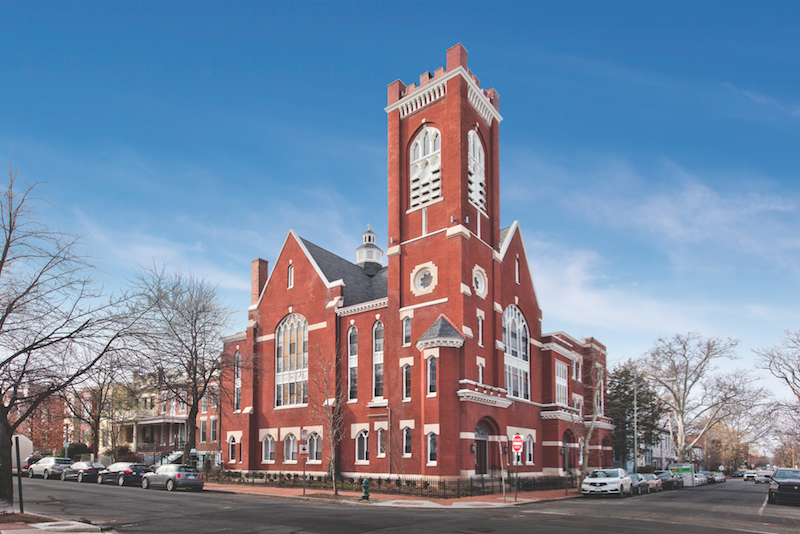 Exterior of the Sanctuary, at 816 D St., NE, Washington, D. C. The original Ninth Street Congregational Church dates from 1898. A three-story classroom annex built in 1916 now includes townhouses.
Exterior of the Sanctuary, at 816 D St., NE, Washington, D. C. The original Ninth Street Congregational Church dates from 1898. A three-story classroom annex built in 1916 now includes townhouses.
The church and its adjacent annex came on the market in 2014. The congregation had been migrating to the Maryland suburbs, and the sale of the church helped them finance construction of a larger building in Capitol Heights, Md. After some ownership changes, the quarter-acre property came under control of The Rubin Group, in partnership with real estate finance firm Regua. Andrew T. Rubin, Principal in the family-owned firm, brought in Bill Bonstra, FAIA, LEED AP, Founder of Washington design firm Bonstra | Haresign Architects, to lead the project.
In the course of the next two years, Rubin and Bonstra would learn more than they ever wanted to know about stained glass.
GETTING ALL THE NECESSARY APPROVALS
The first item on Rubin and Bonstra’s checklist was to obtain special zoning relief to change the building’s use to residential. Parking was the neighbors’ number one hot button. For years, local residents had been inconvenienced by church members taking up street parking on Sundays and weeknights. After meeting numerous times with the local Advisory Neighborhood Commission and other civic groups, Rubin and Bonstra were able to convince the locals that the parking problem would mostly go away once the church was shifted to residential use—especially with local bus, train, and new H Street trolley service in the neighborhood.
The more vexing problem had to do with the historic nature of the neighborhood. Although the church was not a designated landmark, because it was in the Capitol Hill Historic District and of a certain age, it was deemed a “’contributing building” under the District’s historic preservation guidelines. “Those buildings are what give the district its historical character,” says Gretchen Pfaehler, AIA, a member of the District’s Historic Preservation Review Board (HPRB).
Pfaehler, an Associate Partner at design firm Beyer Blinder Belle, was Chair of the HPRB at the time the Sanctuary came under its purview. She was particularly concerned about the stained glass windows, a subject in which she is an acknowledged authority. Under the code, she says, the windows were considered “artistic elements” that contributed “important character and effect” to the church.
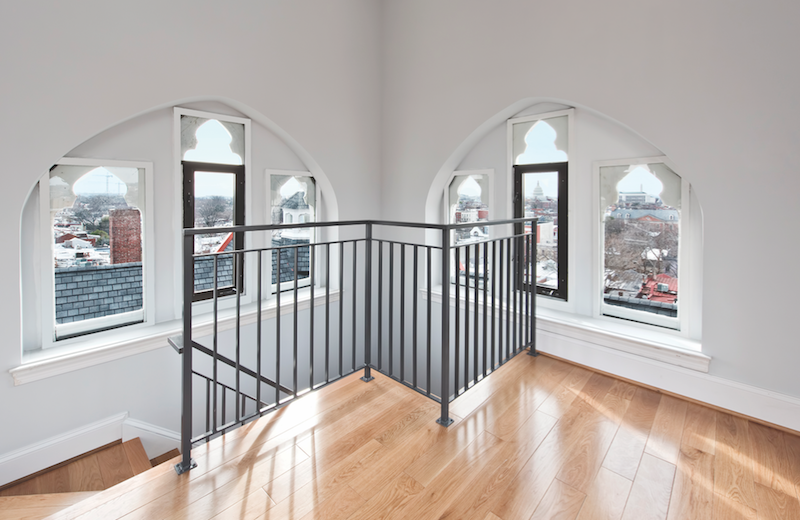 The view from the bell tower (which never had bells)—“now the highest privately owned view in D. C.,” according to developer Andrew T. Rubin.
The view from the bell tower (which never had bells)—“now the highest privately owned view in D. C.,” according to developer Andrew T. Rubin.
That position clashed with Bonstra and Rubin’s desire to make the building more appealing to prospective buyers by replacing translucent lites at eye level with transparent ones in some windows. “Stained glass might be good for spirituality,” Bonstra says, “but when you live in a building, you want to be able to look out the windows.”
The Review Board had denied two previous requests from developers who wanted to replace ornamental glass with clear glass; both decisions were upheld on appeal to the next higher authority. But they gave the Sanctuary team a chance to make the case for switching out the glass.
After conducting an extensive search, Bonstra and Rubin identified the glass restoration expert they believed could help them—Cumberland Stained Glass, Mechanicsburg, Pa. The 25-year-old studio is accredited by the Stained Glass Association of America.
The design team organized a site visit with Pfaehler and representatives from the D. C. Historic Preservation Office, the Capitol Hill Restoration Society, and the Advisory Neighborhood Commission. Cumberland’s President, Bryan Lerew, demonstrated a mocked-up window that illustrated how the lead matrix and ornamental design could be preserved, even if some lites were replaced with specialty transparent glass.
It was a textbook case of the effectiveness of physical mockups in building design. “The mockup did influence us,” says Pfaehler. “It allowed us to see the actual glazing in the appropriate lighting.” Lerew had specified a German-made glass (“Restover”) with a kind of distressed exterior side for the clear lites. The mockup helped overcome Pfaehler’s concerns about the sheen and reflectance of the clear glass as viewed from the street; at the same time, the glass provided the see-through visibility Bonstra and Rubin were looking for.
But the Review Board was not done. “We examined each window in detail to determine how much glass could be replaced without compromising the overall artistry of the window,” says Pfaehler. When Bonstra asked permission to punch holes in a street-facing wall for new windows, the board issued a categorical no. But they did allow new windows on the rear of the church and some operable windows for ventilation.
Following months of negotiation, the Review Board approved the revisions to the windows, although Pfaehler was emphatic that the decision applied only to the Sanctuary and was not to viewed as precedent setting.
Refurbishing the 132 windows took six of Cumberland’s technicians nine months, Lerew says. “The windows were badly out of repair, and the lead had outlived its life,” he says. Cumberland craftsmen painstakingly preserved 75% of the original glass and restored all the original designs. The total cost of the glasswork, according to Rubin: about 10% of the total $15.1 million construction cost.
SHORING UP THE STRUCTURE
The 85-foot-tall bell tower needed major structural reinforcement. “We removed about four feet of the original wall all the way to the basement, then poured a 28-by-42-inch concrete column and laid engineered structural beams,” says Brian Lucey, Potomac Construction Group’s Vice President of Operations.
Inserting the shaft for the new three-story KONE elevator between the church and the old classroom annex proved vexing for Potomac and structural engineer Structura. Concrete in the annex had to be demolished, underpinning placed around the foundations, and new footings laid. “We had to shore up each concrete floor as we moved up, putting in new cinder block shaft walls to the roof,” says Lucey.
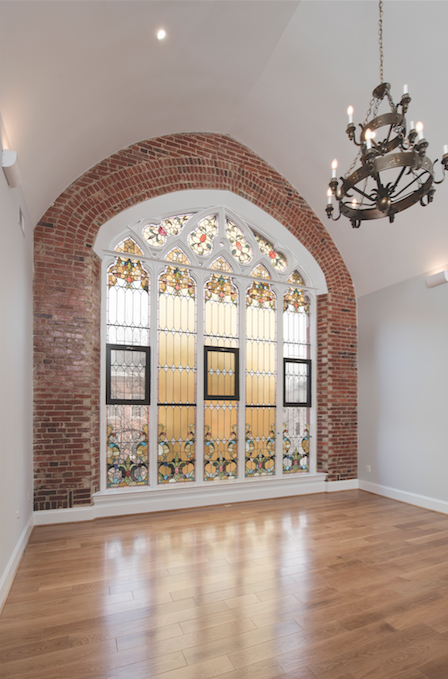 Potomac Construction Group crews carefully preserved light fixtures and original brick throughout the nearly 35,000-sf restoration. Note the special German-made transparent glass and the operable windows, two features the developer and design team worked hard to convince the District of Columbia Historic Preservation Review Board to approve.
Potomac Construction Group crews carefully preserved light fixtures and original brick throughout the nearly 35,000-sf restoration. Note the special German-made transparent glass and the operable windows, two features the developer and design team worked hard to convince the District of Columbia Historic Preservation Review Board to approve.
“The window lines throughout the building varied due to the differences in structure and purpose of the church and annex,” says Colin Drumright, Project Architect, Bonstra | Haresign. “We incorporated these differences into the living units by having double-height spaces and varied floor elevations on the third floor.” Sloped seating in the choir loft was demolished to gain the proper alignment, he notes.
Potomac finished the 34,693-sf job last New Year’s Eve. By September, the 29 one- and two-bedroom units (440 to 1,900 sf) were sold out. The penthouse (two bedrooms/2.5 baths) went for $1,525,000, a condo sales figure the city’s Northeast quadrant had not seen since 2008.
The Sanctuary received an Award of Excellence in Historic Architecture from AIA Northern Virginia. Next month, it will be announced as a winner in Building Design+Construction’s Reconstruction Awards.
The conversion of the church had an almost Damascene effect on the participants. “We felt more like stewards of the building than developers,” says Rubin. “The church started telling us what to do.”
PROJECT TEAM | THE SANCTUARY
CLIENT The Rubin Group, in partnership with Regua ARCHITECT Bonstra | Haresign Architects STRUCTURAL ENGINEER Structura CIVIL ENGINEER VIKA Capitol MECHANICAL ENGINEER Capitol Engineering Group GLASS CONSULTANT Cumberland Stained Glass GC Potomac Construction Group
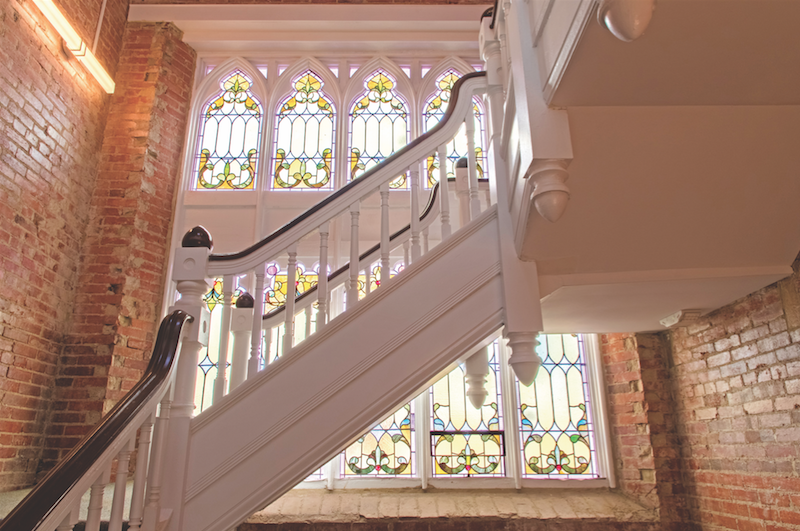 Plaster was removed from the walls in the main stairwell (and elsewhere) to reveal the original brick. The wooden balustrade was restored.
Plaster was removed from the walls in the main stairwell (and elsewhere) to reveal the original brick. The wooden balustrade was restored.
Related Stories
| Mar 17, 2011
Perkins Eastman launches The Green House prototype design package
Design and architecture firm Perkins Eastman is pleased to join The Green House project and NCB Capital Impact in announcing the launch of The Green House Prototype Design Package. The Prototype will help providers develop small home senior living communities with greater efficiency and cost savings—all to the standards of care developed by The Green House project.
| Mar 11, 2011
Renovation energizes retirement community in Massachusetts
The 12-year-old Edgewood Retirement Community in Andover, Mass., underwent a major 40,000-sf expansion and renovation that added 60 patient care beds in the long-term care unit, a new 17,000-sf, 40-bed cognitive impairment unit, and an 80-seat informal dining bistro.
| Mar 11, 2011
Mixed-income retirement community in Maryland based on holistic care
The Green House Residences at Stadium Place in Waverly, Md., is a five-story, 40,600-sf, mixed-income retirement community based on a holistic continuum of care concept developed by Dr. Bill Thomas. Each of the four residential floors houses a self-contained home for 12 residents that includes 12 bedrooms/baths organized around a common living/social area called the “hearth,” which includes a kitchen, living room with fireplace, and dining area.
| Mar 11, 2011
Texas A&M mixed-use community will focus on green living
HOK, Realty Appreciation, and Texas A&M University are working on the Urban Living Laboratory, a 1.2-million-sf mixed-use project owned by the university. The five-phase, live-work-play project will include offices, retail, multifamily apartments, and two hotels.
| Mar 1, 2011
How to make rentals more attractive as the American dream evolves, adapts
Roger K. Lewis, architect and professor emeritus of architecture at the University of Maryland, writes in the Washington Post about the rising market demand for rental housing and how Building Teams can make these properties a desirable choice for consumer, not just an economically prudent and necessary one.
| Feb 15, 2011
New Orleans' rebuilt public housing architecture gets mixed reviews
The architecture of New Orleans’ new public housing is awash with optimism about how urban-design will improve residents' lives—but the changes are based on the idealism of an earlier era that’s being erased and revised.
| Feb 11, 2011
Chicago high-rise mixes condos with classrooms for Art Institute students
The Legacy at Millennium Park is a 72-story, mixed-use complex that rises high above Chicago’s Michigan Avenue. The glass tower, designed by Solomon Cordwell Buenz, is mostly residential, but also includes 41,000 sf of classroom space for the School of the Art Institute of Chicago and another 7,400 sf of retail space. The building’s 355 one-, two-, three-, and four-bedroom condominiums range from 875 sf to 9,300 sf, and there are seven levels of parking. Sky patios on the 15th, 42nd, and 60th floors give owners outdoor access and views of Lake Michigan.
| Feb 11, 2011
Sustainable community center to serve Angelinos in need
Harbor Interfaith Services, a nonprofit serving the homeless and working poor in the Harbor Area and South Bay communities of Los Angeles, engaged Withee Malcolm Architects to design a new 15,000-sf family resource center. The architects, who are working pro bono for the initial phase, created a family-centered design that consolidates all programs into a single building. The new three-story space will house a resource center, food pantry, nursery and pre-school, and administrative offices, plus indoor and outdoor play spaces and underground parking. The building’s scale and setbacks will help it blend with its residential neighbors, while its low-flow fixtures, low-VOC and recycled materials, and energy-efficient mechanical equipment and appliances will help it earn LEED certification.
| Feb 11, 2011
Apartment complex caters to University of Minnesota students
Twin Cities firm Elness Swenson Graham Architects designed the new Stadium Village Flats, in the University of Minnesota’s East Bank Campus, with students in mind. The $30 million, six-story residential/retail complex will include 120 furnished apartments with fitness rooms and lounges on each floor. More than 5,000 sf of first-floor retail space and two levels of below-ground parking will complete the complex. Opus AE Group Inc., based in Minneapolis, will provide structural engineering services.
| Jan 27, 2011
Perkins Eastman's report on senior housing signals a changing market
Top international design and architecture firm Perkins Eastman is pleased to announce that the Perkins Eastman Research Collaborative recently completed the “Design for Aging Review 10 Insights and Innovations: The State of Senior Housing” study for the American Institute of Architects (AIA). The results of the comprehensive study reflect the changing demands and emerging concepts that are re-shaping today’s senior living industry.


